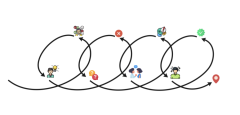Nomura, J., 1998. Commodity color theory – the study of utility development by color. Chikura Shobo.
For this intervention, The painting I chose comes from my friend. He is an art student who is studying surreal painting recently.

Step 1: Choose the instrument’s sound, note and scale.
1. What instrument’s sound should I choose?
I extracted the four main colors in this work (Vermillion, Dark blue, Yellow and black.) and referred to Kandinsky’s color theory. The Tuba represents vermilion, the cello represents dark blue and the trumpet represents yellow.
2. Which note in C major should I choose? (do,re,mi,fa,so,la,si)
I referred to Newton’s Musical Color Wheel. Vermilion- E (re), Blue- A (so), Yellow-F (mi).
3. Which scale sound should I choose?
Nomura (1985) “Commodity Color Theory” explains the scale and color listening: “From all the scales, the high scale tends to be bright and smooth, and the children’s scale is normalized to light and dark colors, and the strongest tone is Will be close to this color, the weakest tone color is newly blurred, and is close to the target; the scale of the flat semitone will remind people of the warm color system, the scale of the sharp semitone is the color system; the gentle music music singer blue association, fast Rhythmic music has a red association; high notes represent bright colors, while low notes are dull.”
This is about ideasthesia. From the perspective of lightness, dark colors are bass and bright colors are treble. Because this painting has a deeper feeling overall, I will use a lower tone.
Step 2: Using virtual instrument to create sound
Refer to the sound of different instruments in youtube:

Step 3 : Combine music and painting
Step 4: Design questionnaire to collect feedbacks
